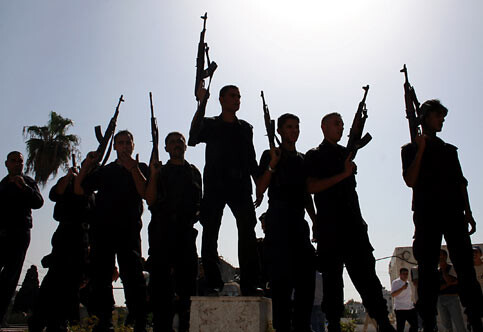The Electronic Intifada 9 October 2005

Armed Palestinian policemen protest in Gaza City on Monday after storming the in-session parliment to demand better equipment. 3 October 2005. (Photo: Wesam Saleh, Ma’an News Network)
Bethlehem - “At least give us enough bullets to protect people and protect our stations,” exclaimed a Palestinian police officer after he stormed the parliament building in Gaza City on the afternoon of October 3rd. He was one of approximately 40 officers from the Shati refugee camp who raided the in-session parliament to protest the Palestinian Authority’s reaction to fierce clashes between PA forces and Hamas militants in Gaza City on the night of October 2nd. One policeman and two bystanders were killed and 43 others were wounding in six hours of intense street fighting throughout the city.
It appears that the clashes erupted when four Hamas militants opened fire on Palestinian police who attempted to confiscate their weapons. The skirmish quickly escalated with armed members of the Fatah movement joining the police and Hamas sympathizers rushing to bolster the opposing front. Before the fighting subsided, police stations in the Sheikh Redwan and Shati neighborhoods had come under intense rocket-propelled grenade and automatic weapons fire by Hamas operatives.
The battle illustrates the precarious state of affairs between the Fatah dominated PA and the Hamas movement inside the Gaza Strip. While the PA is tasked with mitigating political turmoil in post-withdrawal Gaza, its police and security forces are under immense pressure to impose law and order on the street. The trouble, however, is that the national forces lack sufficient weaponry to confront large militant organizations intent on retaining arms and controlling the street.
On July 25th, the Washington-based Strategic Assessments Initiative published an 83-page report outlining myriad weaknesses within the PA security forces. Conducted in close cooperation with Lt. Gen. William Ward, the American appointed coordinator to overhaul the Palestinian security apparatus, the report found the forces divided, weak, overstaffed, poorly motivated and underarmed. The report indicated that the current ratio of personnel to arms among the PA forces is 4 to 1, with acutely insufficient levels of ammunition, fighting vehicles, and necessary military accessories.
By contrast, the assessment claimed that “non-state actors,” such as Hamas and other militant organizations, are “relatively well armed.” Unfortunately, it is precisely these “non-state” actors that Israel and the international community require President Abbas’ government to disarm and “dismantle” as a prerequisite for further negotiations. In a meeting with Israeli Prime Minister Sharon at the UN General Assembly in New York last month, American President George Bush indicated that the peace process would not move forward without the PA first establishing “order” in the Gaza Strip.
One month ago President Abbas issued a decree banning the display of weapons in public. On September 29th, additional Palestinian police and security forces deployed throughout the Gaza Strip in a bid to enforce the measure, which many major armed factions rejected outright. Given the reported nature of what prompted Sunday night’s clashes, the events illustrate what may become a frequent occurrence as poorly armed PA forces attempt to dictate to the superior manpower, training and weaponry of Hamas’ armed brigades.
Given the arms disparity and the expansive support that Hamas enjoys in Gaza, the PA will be largely unable to consolidate control without sufficient weaponry. While Israel and the international community have the right to demand results from the PA in Gaza, they must provide its security forces with the tools and support necessary to procure success. It is unreasonable to expect President Abbas and his security forces to win gun battles with slingshots.
The morning after the clashes Hamas’ resolve appeared intact, if not emboldened. A statement released by the movement’s Damascus-based leader Mohammed Nazel threatened that Hamas will risk civil war in order to confront Palestinian factions that seek its “eradication.” Clashes the likes of those on Sunday night are sure to become increasingly frequent as tension between Hamas and the Fatah-controlled PA grows more acute. If Israel and the international community are serious about progress through the existing Palestinian leadership, it must supply that leadership with the hardware necessary to implement reform on the street.
Peter Muller is an editor at the Ma’an News Agency in Bethlehem, Palestine. He arrived in the West Bank in May 2005 and began work with Ma’an in June. He is a graduated from the American University in Washington D.C. where he studied the history of ethnic conflict and genocide.


